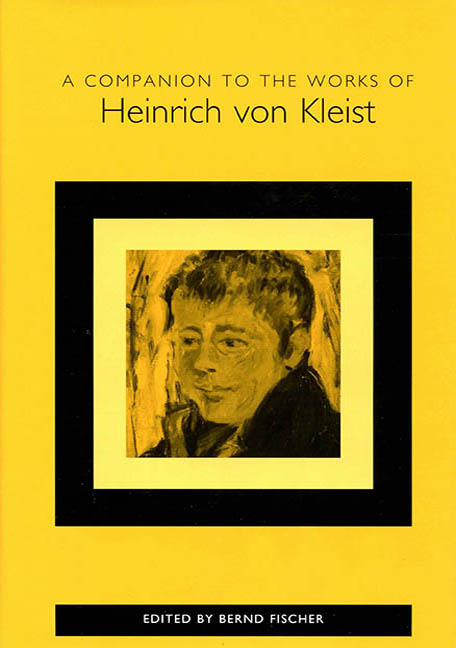Book contents
- Frontmatter
- Contents
- Introduction: Heinrich von Kleist's Life and Work
- Critical Approaches
- Language and Form
- On Structures in Kleist
- Strange News: Kleist's Novellas
- The Eye of the Beholder: Kleist's Visual Poetics of Knowledge
- The Performative Turn of the Beautiful: “Free Play” of Language and the “Unspeakable Person”
- Intellectual Paradigms
- Themes and Motifs
- Notes on the Contributors
- Index
On Structures in Kleist
from Language and Form
Published online by Cambridge University Press: 27 April 2017
- Frontmatter
- Contents
- Introduction: Heinrich von Kleist's Life and Work
- Critical Approaches
- Language and Form
- On Structures in Kleist
- Strange News: Kleist's Novellas
- The Eye of the Beholder: Kleist's Visual Poetics of Knowledge
- The Performative Turn of the Beautiful: “Free Play” of Language and the “Unspeakable Person”
- Intellectual Paradigms
- Themes and Motifs
- Notes on the Contributors
- Index
Summary
Symmetry and Its Ambivalences
In February 1808 Kleist wrote to the author and theater director Heinrich Joseph von Collin, from whom he hoped, among other things, to elicit a contribution for his journal Phöbus. A number of eminent literary figures had already turned a deaf ear to Kleist's appeal for contributions. Phöbus was clearly in difficulties, and, likely with more bravado than veracity, Kleist declares that in addition to Penthesilea, he has two more complete tragedies from his own pen from which he will publish extracts: “Das erste Werk, womit ich wieder auftreten werde, ist Robert Guiskart, Herzog der Normänner. Der Stoff ist … noch ungeheurer; doch in der Kunst kommt es überall auf die Form an, und Alles, was eine Gestalt hat, ist meine Sache” (4:413). His correspondent could scarcely have been aware of the fraught history of Guiskard as Kleist's first attempt at tragic drama in the grand manner, and there is also no indication in this letter that Penthesilea, then in the process of being published, would be the author's last completed tragedy.
Quite apart from any strategic departures from or distortions of the facts about his store of manuscripts in early 1808, what is claimed in his letter to Collin is both true and not true of his own command of artistic form, the clash of authorial perspectives on his own work betraying the quintessential Kleist. Confidence in his own mastery over anything possessing “eine Gestalt” sits oddly with the many contemporary perceptions of structural weaknesses or blemishes in his dramas. That Robert Guiskard never realized the full potential in which Kleist had placed so much hope when he had begun writing it in 1802 is balanced, from the standpoint of the early twenty-first century, by the formal perfection of Prinz Friedrich von Homburg, in which he succeeds both in creating a well-shaped tragedy and in encapsulating it in another kind of drama altogether.
To address some of the questions surrounding structures in Kleist's work as a whole is, thus, to broach the issue of the inconstancy of his talent, an enigma as difficult to grasp for Kleist's contemporaries as it is for the abundant scholarship that thrives on expounding his works today.
- Type
- Chapter
- Information
- A Companion to the Works of Heinrich von Kleist , pp. 63 - 80Publisher: Boydell & BrewerPrint publication year: 2003



